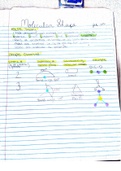Vespr theory - Study guides, Revision notes & Summaries
Looking for the best study guides, study notes and summaries about Vespr theory? On this page you'll find 10 study documents about Vespr theory.
All 10 results
Sort by
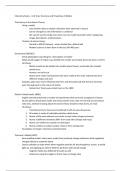 Popular
Popular
-
ON Curriculum - Course Notes Gr 12 Chemistry
- Summary • 36 pages • 2023
-
- £3.07
- 1x sold
- + learn more
Covers in-depth complete course notes for grade 12 chemistry (university level). Includes topics: 1. Structure and Properties of Matter - History of the Atomic Theory - Various historic models and theories - Electromagnetic Spectrum - Schrodigner’s Equation - Quantum chemistry - VESPR 2. Energy Changes and Rates of Reaction - Laws of thermodynamics - Enthalpy - Calorimetry and Calorimeters - Hess' law - Reaction types - Rates of reaction - Collision theory - Maxwell-Boltzm...
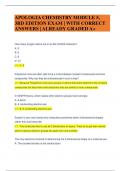
-
APOLOGIA CHEMISTRY MODULE 5, 3RD EDITION EXAM | WITH CORRECT ANSWERS | ALREADY GRADED A+
- Exam (elaborations) • 4 pages • 2024
-
- £6.07
- + learn more
How many oxygen atoms are in an Al2 (CO3)3 molecule? A. 3 B. 6 C. 9 D. 12 C. 9 Polyatomic ions are often said to be a cross between covalent compounds and ionic compounds. Why can they be characterized in such a way? Because Polyatomic ions have groups of atoms that share electrons like covalent compounds but they have extra electrons that are similar to ionic compounds. In VESPR theory, which repels other electron groups more strongly: A. A bond B. A nonbonding electron pai...
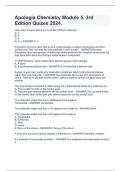
-
Apologia Chemistry Module 5, 3rd Edition Quizes 2024.
- Exam (elaborations) • 2 pages • 2024
- Available in package deal
-
- £7.68
- + learn more
Apologia Chemistry Module 5, 3rd Edition Quizes 2024.How many oxygen atoms are in an Al2 (CO3)3 molecule? A. 3 B. 6 C. 9 D. 12 - ANSWER C. 9 Polyatomic ions are often said to be a cross between covalent compounds and ionic compounds. Why can they be characterized in such a way? - ANSWER Because Polyatomic ions have groups of atoms that share electrons like covalent compounds but they have extra electrons that are similar to ionic compounds. In VESPR theory, which repels other electr...
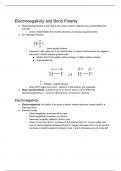
-
CHEM 130 Chapter 5: Chemical Bonding I
- Lecture notes • 18 pages • 2024
- Available in package deal
-
- £4.99
- + learn more
Class notes for Chapter 5: Chemical Bonding I in the class General Chemistry: Macroscopic Investigations and Reaction Principles (CHEM 130) at the University of Michigan. Topics covered include electronegativity, bond polarity, Lewis structures, resonance, octet rule and exceptions, and VESPR theory.
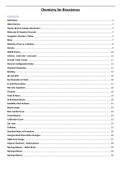
-
401SCI Chemistry for Biosciences
- Lecture notes • 30 pages • 2023
-
- £7.49
- + learn more
A summary of all lectures and key information in an easy to understand format. Topics include: Atomic Mass & Isotope distribution, Molecular & Empirical Formula, Avogadro’s Number / Moles, Mass, Molarity of Ions in a Solution, Density, VESPR Theory, Valency - Lewis Dot - Lone pairs, Periodic Table Trends, Electron Configuration Rules, Chemical Quantities, Bonding, pH and pOH, Kw (Ionisation of H₂O), Ka Acid Dissociation, Net Ionic Equations, Titration, Acids & Bases, Acid Nomenclature, Solub...
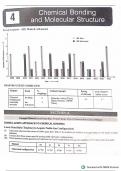
-
Class 11 inorganic chemistry chemical bonding and molecular structure
- Summary • 47 pages • 2024
-
- £15.76
- + learn more
Title: Class 11 Inorganic Chemistry - Chemical Bonding and Molecular Structure This comprehensive set of notes covers the essential concepts of Chemical Bonding and Molecular Structure from Class 11 Inorganic Chemistry. It explains various types of bonds such as ionic, covalent, and coordinate bonds, along with detailed explanations of bond parameters like bond length, bond energy, and bond angle. The notes also delve into molecular orbital theory, VSEPR theory, and hybridization, making comp...
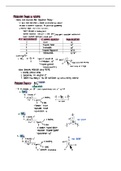
-
Chapter 9 CHEM 1210 OSU
- Lecture notes • 6 pages • 2022
-
- £6.45
- + learn more
Comprehensive, written notes with information from lecture, the textbook, and tutoring. Chapter 9, all about molecular shapes, from CHEM 1210 at OSU. This note goes in depth on definitions, has many examples, and great figures drawn to explain the difficult concepts in easier ways. In this document you can learn about molecular shapes, VESPR, molecular orbital theory, hybrid and overlapping orbitals, formal charge, etc.
Provides information regarding molecular shale and VESPR theory
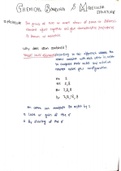
-
Chemical Bonding | Class XI | Notes
- Interview • 59 pages • 2023
-
- £7.30
- + learn more
These are my handwritten class notes on Chemical Bonding for class 11 and JEE aspirants You can get the detailed theories of every topic in this chapter and To make it attractive to read I have used colorful pens. I hope this will help in your studies
Summary of VSEPR Theory and DIPOLE MOMENT

£5.50 for your revision notes multiplied by 100 fellow students... Do the math: that's a lot of money! Don't be a thief of your own wallet and start uploading yours now. Discover all about earning on Stuvia



